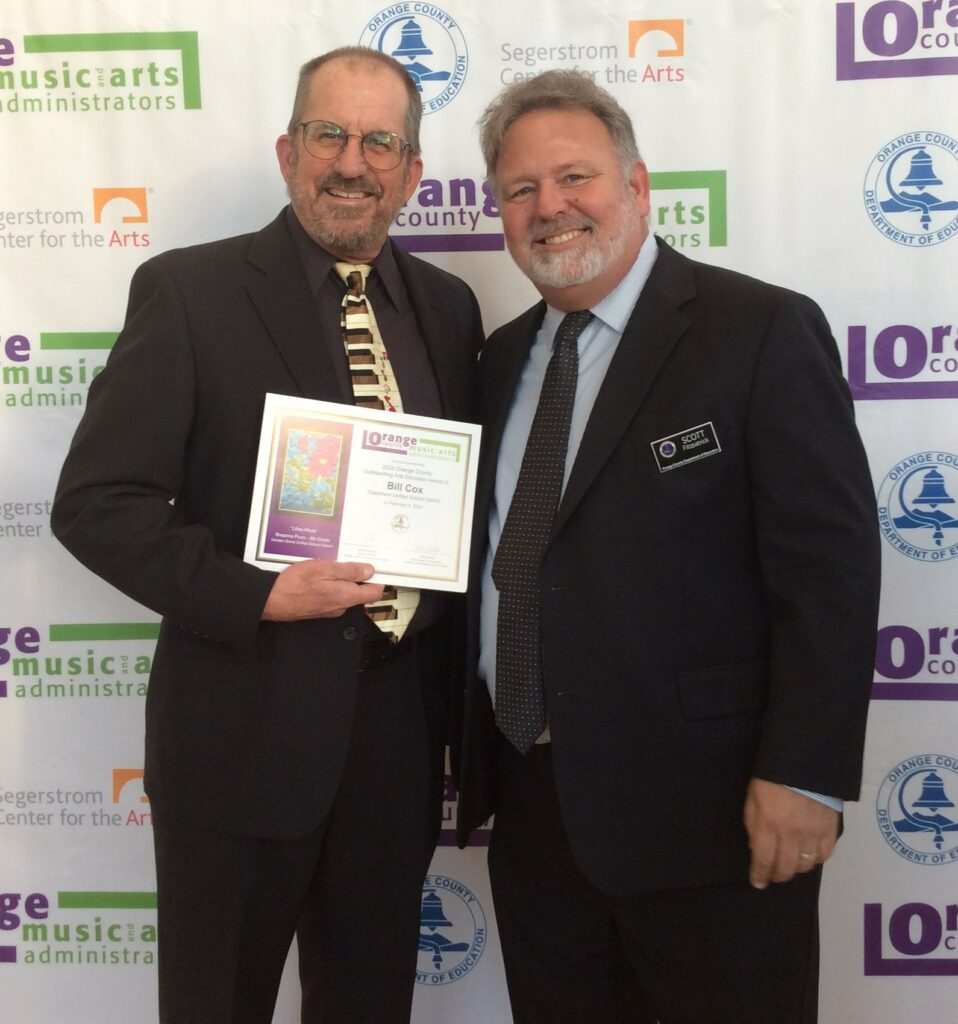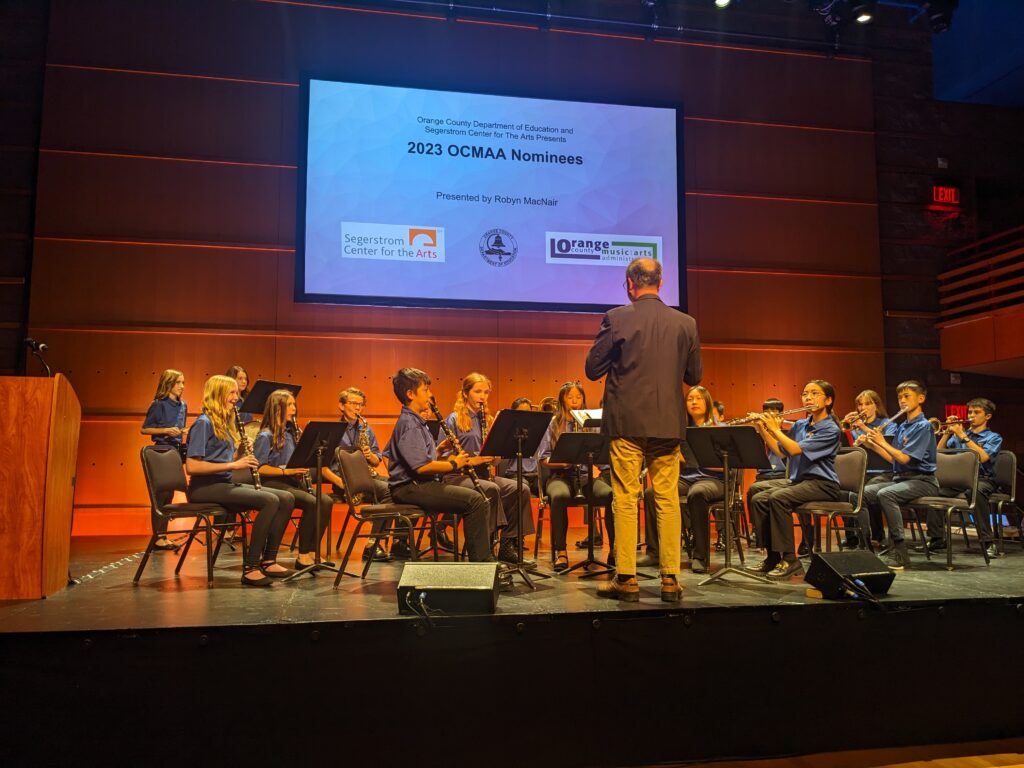Helping students succeed from K-12 to college and beyond has been a priority for Orange County educators, and with funding from Measure 28, opportunities to learn through the arts may further expand on school campuses.
Through the state’s efforts to promote arts education, the Arts and Music in Schools Funding Guarantee and Accountability Act, or Measure 28, was passed in November of last year and allocates 1 percent — or roughly $941 million — of the general fund every year to K-12 arts programs throughout California.

Endorsed by former education professionals and prominent musicians, the increase in funding will help districts provide greater access to enriching cultural and arts experiences for more students, as well as expanded opportunities in the fields of music, dance, media arts, theatre and visual arts. A portion of the funding will also be dedicated to hiring new arts educators in local school districts to offer a variety of artistic disciplines to K-12 classrooms.
For a closer look at what’s in store for Orange County, the OCDE Newsroom spoke with OCDE Visual and Performing Arts Coordinator Scott Fitzpatrick about countywide plans for utilizing Measure 28 in support of district arts programs.
***
How does OCDE provide supports to local arts and music educators?
The Orange County Music and Arts Administrators, known as OCMAA, represents a community of practice for arts education here in Orange County. Through our work with leaders from multiple districts, we focus on specific curriculum for each school year. In this process, we are constantly digging into our framework and standards for arts education with focuses that are relevant to the needs of students that districts identify. After we present the chosen topics to district arts leaders and teachers, they share with us how they are implementing this curriculum with their teams and their students.
Overall, our organization is committed to equity of student access and the idea that all means all. We support focused conversations between districts and community arts partners through monthly meetings with districts. At these meetings, a district will share its current arts programming, vision and goals to attending arts organizations.
We also promote relationships between families, communities and school districts by supporting the Arts Now Communities Program and hosting arts coordinator roundtables with representatives from multiple Orange County school districts to discuss district arts leadership and creating Local Control Accountability Plans, or LCAPs, that provide parents with information about how arts programs align with their district’s priorities.
Through our partnership with Arts Orange County, we hold our county-wide student art showcase called “OCArts4All,” which celebrates student artwork in Orange County. We also support the Creative Edge Lecture Series and their Poetry Out Loud program in which students select, memorize and recite poetry that resonates with them.
We support the arts community broadly through the annual OCMAA Awards, which is hosted by Segerstrom Center for the Arts. This annual event celebrates teachers, administrators and community advocates in arts education.
In what ways will proposed changes in arts education funding affect the current resources available to K-12 students?
This promises to be a long-term source of growth for arts education across our state. The future looks bright in many ways as 80 percent of the funding will be dedicated to hiring new teachers, 19 percent for materials, supplies and arts partnerships, and 1 percent will go toward administrative costs.
While the county waits on specifics for reporting guidelines and waivers, districts can map the assets they currently have in place and begin to plan ahead for growth. Additionally, since the funds are intended to supplement current funding, I can envision an increase and variety in arts educational programming made available to students.
As the state encourages us to look to draw on students’ culture to shape curriculum and instruction and to promote respect for student differences, there could not be a better time to re-envision class offerings to ensure that students see themselves in the materials that are presented and designed. By intentionally celebrating the diversity of our students as assets in our curricular design, we can set the stage to promote a sense of inclusion and belonging for young people in our region for years to come.
When is Measure 28 expected to take effect in K-12 schools?
Measure 28 will begin to have an impact with the next fiscal year. The impact of the proposed funding reduction to the block grant will vary by district — some have already made plans to use these funds for needed facilities, materials and supplies in preparation for Measure 28.
In general, grant funding is temporary and in this specific case, the use of funds is optional. The good news with Measure 28 is that the funding will be ongoing and there will be reporting guidelines to make sure that funds are used to support arts education specifically.
Measure 28 has been the topic of conversation during multiple monthly OCMAA meetings with districts, so our organization is currently engaging in countywide strategic planning for arts education in multiple districts. During these sessions, districts share their current plans and ask questions that are brought back to the California County Superintendents network.
Our team at OCDE will continue to hold conversations and share information that we receive to support districts through OCMAA meetings and additional network sessions focused on Measure 28.
What kind of positive outcomes might school districts and their communities see in regards to arts education experiences?
We hope to see current students experience a sense of connectedness to their schools and communities long-term through these educational arts experiences that are made available through strategic planning and community engagement. We have seen how the arts can support students’ social-emotional needs and the whole child. With this new investment in arts education, we have the opportunity to see new arts educational experiences that will go beyond our traditional focuses on performance, presentation and production, and into the other artistic processes we teach — creating, responding and connecting.
Beyond traditional arts offerings, strategic planning for Measure 28 may lead to a greater diversity of class offerings. For example, a district with a strong marching band program may look to expand musical class offerings to include things like mariachi music, gagaku Japanese music, or ukulele.

These artistic processes may be enriched by more students experiencing connections with the materials while having the opportunity to create their own artworks. Our team is looking forward to more intentionally celebrating both the product that the public enjoys and the process students go through in developing and refining their ideas to produce art in the years to come.
It is my hope that dedicated funding for arts educators will allow teachers and students to engage more deeply in all four artistic processes.
What should educators and families know about the future for arts education in Orange County schools?
I would like educators and families to know that arts education is headed in a positive direction for Orange County students and now is the time to get involved.
During my short time here at OCDE, I have been honored to be in discussions about distance learning and about rolling out our new framework and standards. We are currently having discussions about the passage of the block grant and Measure 28. Through these conversations, it has become even more apparent that district leaders and teachers are committed to supporting their students.
The coalition of Orange County arts leaders that support one another through the OCMAA is committed to the idea that students will transfer the knowledge and skills learned in the arts to support them long term beyond the arts classroom to careers, but also to increase engagement and well-being. I can tell you that the future of arts education for Orange County students is bright because of the commitment and character of these amazing people I have listened to and spoken with.
Our county strategic arts plan we are currently drafting has an identified core value — an enduring and active coalition. I am confident that this coalition for the arts will endure and remain active as we share best practices and support one another while better supporting students countywide in the long term.
How can families get involved with arts programs in their school or district?
This is a great time for families to get involved in supporting their districts at this time. They can join the Arts Now Communities program and receive training on how to be a part of their district’s Local Control Accountability Plan to support the arts.
For more information on visual and performing arts resources for Orange County students, head to ocde.us/artsadvantage. Orange County community partners that would like to get involved in their district’s arts strategic planning can contact Arts Now community ambassador Shanin Ziemer for more information at artsnow.shanin@gmail.com.
